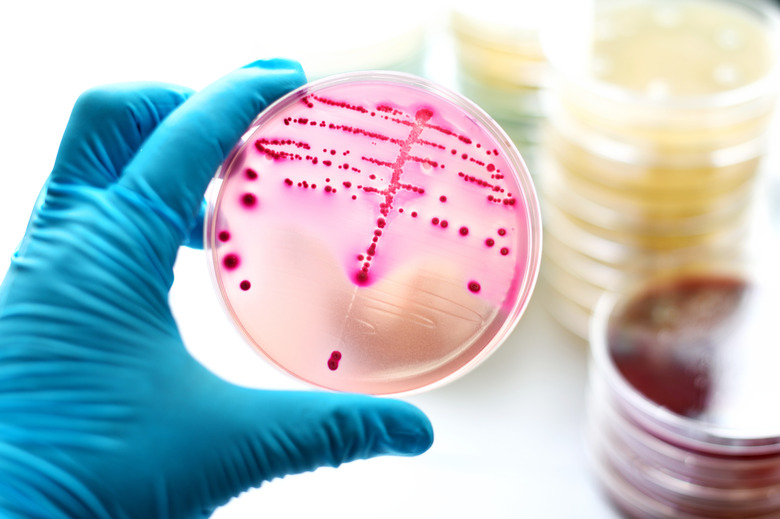What Three Conditions Are Ideal For Bacteria To Grow?
The bare necessities humans need to live are food, water and shelter. Bacteria have these same needs; they need nutrients for energy, water to stay hydrated, and a place to grow that meets their environmental preferences. The ideal conditions vary among types of bacterium, but they all include components in these three categories.
Bacterial Nutrient Needs
Bacterial Nutrient Needs
While different types of bacterium have varying diets, they all require nutrients to provide energy. Energy is necessary to fuel work inside the cell. Many bacteria use the carbon, nitrogen, phosphorus or sulfur from their nutrient source to produce energy. These elements are broken down during cellular respiration to make a coenzyme called adenosine triphosphate, which transports that chemical energy to places within the cell that are consuming energy. Some bacteria get their energy from sunlight using unique metabolic methods. Scientists who grow bacteria in a laboratory use concentrated growth media containing readily available carbon, nitrogen, sulfur and phosphorus along with many vitamins and minerals. They choose different media depending on the preference of the bacterium they wish to grow.
Bacteria Need a Source of Water
Bacteria Need a Source of Water
Approximately 70 percent of a bacterial cell is composed of water. Complex multi-cellular organisms, such as humans, can ingest their own water. Single-celled bacteria lack that ability, so they must rely on finding enough available water in their environment to through their cell membranes. Many bacteria can survive for extended periods without moisture, but without it they can't grow and reproduce.
Environmental Conditions for Bacteria
Environmental Conditions for Bacteria
Outside of nutrients and water, each species of bacteria has a specific environmental preference. Preferences include the best pH, temperature range, amount of light, concentration of gases such as oxygen and carbon dioxide, and amount of pressure present. The pH conditions may be acidic with pH levels from 6 to 1; alkaline with pH levels from 8 to 14; or somewhat neutral with a pH of around 7. Many bacteria grow well at or near a neutral pH of 6.0 to 8.0. Temperatures also vary, with most flourishing in the range between 40 degrees Fahrenheit and 140 F, or 5 degrees Celsius to 60 degrees C. Some bacteria that need oxygen for their metabolism can use the 10 to 12 percent available in the atmosphere, but that amount of oxygen can be lethal to other bacteria. Other species require an oxygen-free environment, or a high level of carbon dioxide. Environmental pressure such as osmotic pressure and atmospheric pressure are also important.
Bacteria Adapt to Varying Conditions
Bacteria Adapt to Varying Conditions
Bacterial species all have a preferred environment for optimal growth, but are flexible enough to adapt to conditions that are less than ideal. Each bacterial species has its own range of minimal and ideal conditions, within which it can survive or flourish. To grow a given bacterium in the laboratory, it should be provided with conditions that match, as closely as possible, the conditions under which it was originally observed and collected.
Cite This Article
MLA
Taylor, Stacy. "What Three Conditions Are Ideal For Bacteria To Grow?" sciencing.com, https://www.sciencing.com/three-conditions-ideal-bacteria-grow-9122/. 9 March 2018.
APA
Taylor, Stacy. (2018, March 9). What Three Conditions Are Ideal For Bacteria To Grow?. sciencing.com. Retrieved from https://www.sciencing.com/three-conditions-ideal-bacteria-grow-9122/
Chicago
Taylor, Stacy. What Three Conditions Are Ideal For Bacteria To Grow? last modified March 24, 2022. https://www.sciencing.com/three-conditions-ideal-bacteria-grow-9122/
